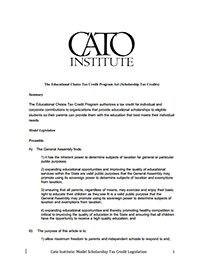Introduction
In most of the country, a student’s access to educational opportunities is primarily determined by zip code and accident of birth. Wealthier families can afford to live in high-performing public school districts or to send their children to independent schools. Unfortunately, millions of low- and middle-income families only have one choice: their local, assigned district school.
Since no one school can best meet the diverse needs of all the children living in a given geographic area, policymakers have sought innovative methods of expanding educational opportunities.
The global research literature overwhelmingly demonstrates that student outcomes improve when parents are free to choose among a variety of schooling options. Likewise, a literature review of domestic research on educational choice programs revealed that 11 of 12 randomized-controlled studies—the gold standard of social science research—found that choice programs had a positive impact on participating students' academic performance. One study found no statistically significant difference. No gold standard study has found a negative impact. Other recent studies have found that school choice programs produce higher graduation rates, higher college enrollment, and even increased civic-mindedness.
Expanding educational choice and competition can also benefit students who remain at government-run district schools. In total, 22 of 23 studies have found that the academic performance of district school students improves as a result of increased competition. No study has found a negative outcome.
The most popular form of private educational choice program is the scholarship tax credit (STC) program. STC programs grant tax credits to individuals and/or corporations who donate to non-profit scholarship organizations that fund low- and middle-income students attending independent or home schools. There are currently more than 150,000 students participating in 16 STC programs operating in 13 states.
In survey after survey, parents of scholarship recipients express high levels of satisfaction with their chosen schools. In 2013, 98.6 percent of parents of scholarship recipients in Georgia reported being "very satisfied" or "satisfied" with their chosen school.
When designed and implemented properly, STC programs can expand educational options while saving money. Studies of the financial impact of STC programs in three states found that they saved money by decreasing government expenditures more than they decreased tax revenue. The most comprehensive study by the Florida legislature's nonpartisan Office of Program Policy Analysis and Government Accountability found that the Sunshine State’s STC program saved $1.44 in state expenses for every $1.00 of forgone state tax revenue.
Unlike school voucher programs, STC programs do not utilize public funds. That means they are more likely to pass constitutional muster where state constitutions forbid the expenditure of public funds at parochial schools. Likewise, STC programs are less likely to be over-regulated."
The model legislation proposed here shows how state-level policymakers can design a scholarship tax credit program that expands educational opportunities for the families who need them most without imposing any unnecessary or counterproductive regulations.
